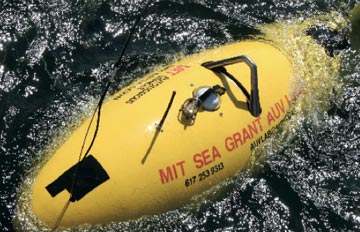
A critical challenge for energy companies running deepwater oil and gas operations is inspecting, maintaining, and repairing complex equipment at unprecedented ocean depths. Today, remotely operated underwater vehicles (ROVs) are invaluable in inspecting subsea structures and sending real-time videos and environmental data to human operators who supervise the task at hand. But those vehicles are connected by a data and power tether – a heavy cable that can be miles long and can easily get tangled and damage subsea structures.
About 20 years ago, researchersat the MIT Sea Grant College Program started working on a solution: a small underwater vehicle that could do all those tasks without tethers, cables, or direct human intervention. Since then, MIT Sea Grant – as well as researchers in other MIT programs and at other universities – has developed so-called autonomous underwater vehicles (AUVs), which now work alongside the ROVs. Without the tether, the AUVs can be lighter, smaller, more maneuverable, and far less expensive than their tethered counterparts. But with no cable to transmit signals, communication with a human operator is difficult – and today’s AUVs aren’t quite ready to do the necessary tasks without instruction. As a result, they are generally limited to collecting data and delivering it to the surface.
MIT teams are now working to make AUVs that can perform more complex functions, thereby combining the attractive features of the tethered and the untethered vehicles. Already they have developed an AUV that can cruise efficiently in the deep ocean and then stop to hover near a site of interest or concern. Other research activities focus on extending the vehicle’s capabilities. If all goes as planned, future AUVs will wirelessly send videos of what they’re seeing to onshore operators. They will navigate with no human guidance, simultaneously making a map of their surroundings and pinpointing their own locations on the map. They will monitor nearby ocean currents and eddies, and will respond with maneuvers that keep their travels efficient and precise. And they will anchor firmly onto pipes or other surfaces while they turn a valve or repair a leak.
The articles that follow provide a closer look at that work and its motivations.
AUVs: from idea to implementation
As the search for oil and natural gas resources moves into deeper and deeper water, companies are facing increasing costs. Building and installing a single offshore drilling platform now costs more than a billion dollars, so companies are using their platforms as efficiently as possible. Advances in technology have enabled them to service several oil fields from a single platform, and much of the infrastructure for well operations has moved to the seafloor, which may be as much as 4,000 meters (almost 2.5 miles) below the surface. As a result, inspecting, servicing, and repairing underwater equipment has become an ever-greater challenge.
Navigating blindfolded: Where am I – and where have I been?
Imagine dropping an underwater vehicle into the ocean and having it survey the ocean floor for debris from an accident or examine a ship’s hull for signs of damage. Without any outside guidance or prior knowledge, the vehicle would traverse the target area in a methodical fashion, never repeating itself or going astray and all the while generating a map that shows the surface of interest.
Going with the flow: Pressure sensors help guide ocean-going vessels
Anyone who has steered a boat has experienced the effort needed to keep the boat on course when currents are pushing it in a different direction. Now, MIT researchers have developed sensors that can measure the pressure of flows around an ocean-going vessel so that it can utilize rather than fight those flows, saving energy and improv- ing maneuverability. Other work aims to go a step further: to change flows from patterns that impede progress to patterns that will help.
Making underwater repairs: Helping robots hold on
If an underwater robot is to open a valve or repair a damaged pipe, it needs to anchor itself to a solid surface so it can apply force to carry out its task without pushing itself away. It then needs to detach and move on to its next assignment.
A group of MIT researchers has designed a “controllable adhesion system” for underwater robots that offers the needed features: a high Coil holding force on various geometries Alnico and textures, low energy consumption, chemical resistance to seawater, and low maintenance.
This article appears in the Spring 2011 issue of Energy Futures.